SOIL EOY EXAM
1/129
There's no tags or description
Looks like no tags are added yet.
Name | Mastery | Learn | Test | Matching | Spaced |
|---|
No study sessions yet.
130 Terms
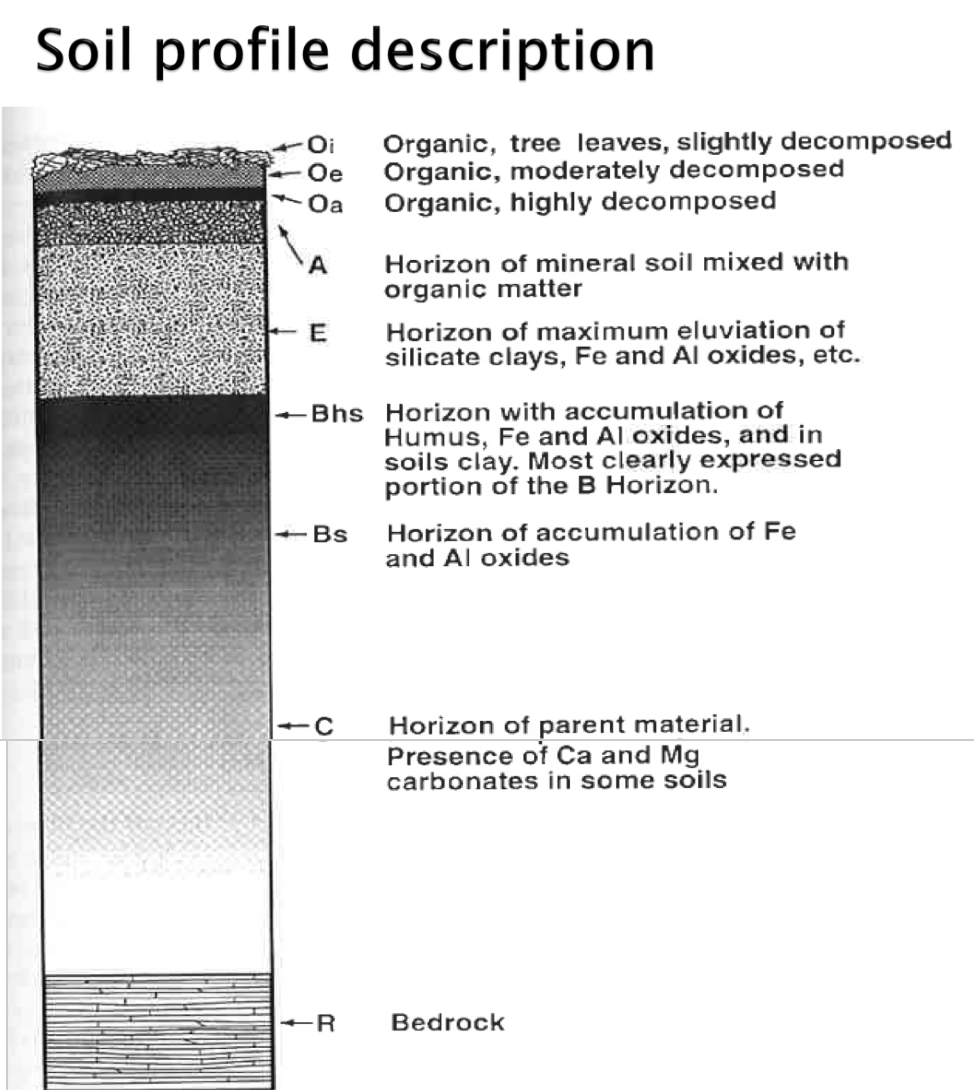
Soil profile
O= lots of decomposed leaves - ranges in size due to vegetation growing
below O is the mineral fraction
A= mineral horizon, mixed with organic material, 10-12cm
E= illuviated, nutrients have been washed out from the soil layers into the subsoil
B= mixed with oxides and elements, different features within; can be well-weathered and waterlogged
Below B = parent material
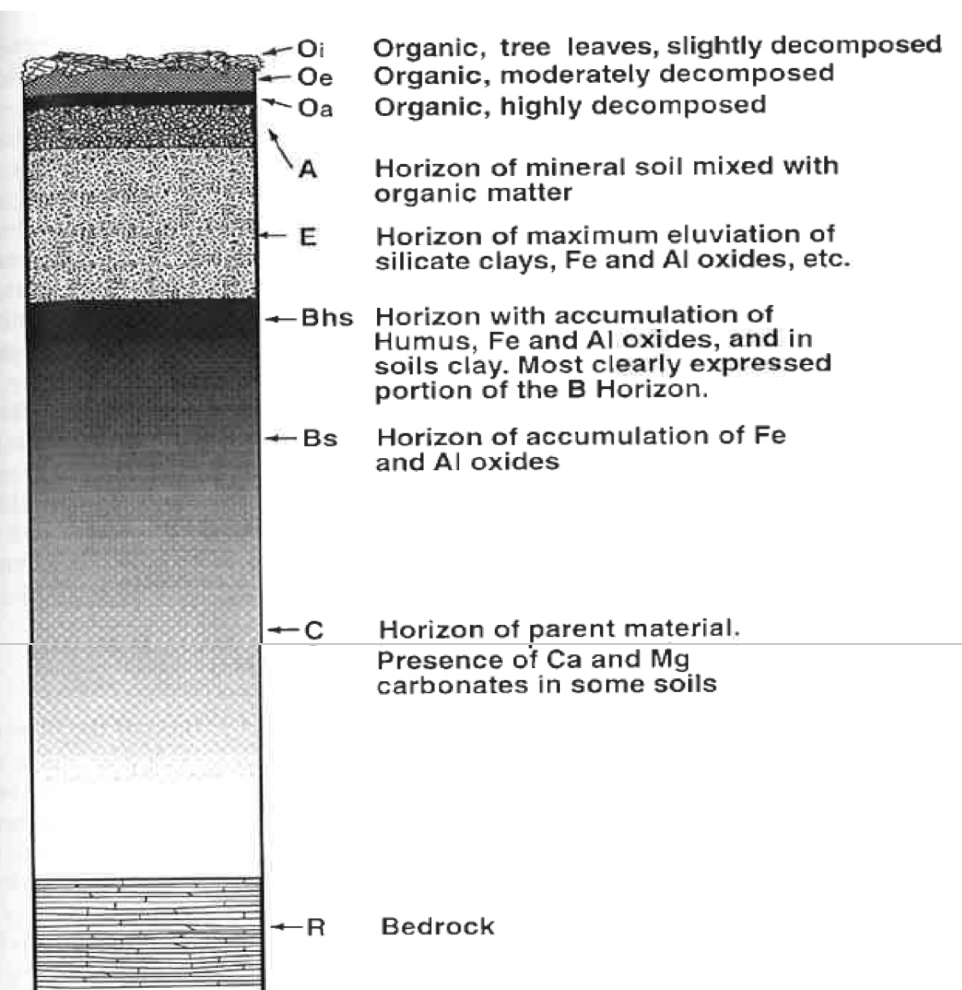
development of soil profile over time
Need climate as a different soil forming factor, need the parent material to break up so fragments can become smaller= develop cracks- have fungi growing into them, getting organic material in the top soil, organic material dies off and new organic material and new organism entering, gets thicker and more translocated within the soil profile and then will develop our AQ and B horizon, above original bedrock.
factors that change the development of soil over time
accumulated organic matter
chemical composition (reactions change the original rock materials)
particle size (usually tending to get smaller- weathering)
redistribution of materials with depth (e.g. clay being washed (eluvial) to lower horizons)
Over time, get mineralization (darkening of soil- happens due to organic material that is incorporated into the soil)
Overtime with lots of rainfall- the soil profile gets older and material leaches out of the topsoil into the sub-soil
relief - chnages in soil profile development
Soil located on top of hill, good drainage, water running down the slope, near the bottom have more grey, anaerobic soils- water cant leave the soil profile
Have both water and nutrient accumulation = accumulate in the bottom of the soil
Nutrient rich soil in valley positions, but not good to grow plants due to lack of oxygen (anaerobic soils)
soil forming factors
The combination of natural processes by which soils are formed
Parent material- parent material needs to be weathered either physically ( freeze and thaw cycle, wind ) or chemically (rain- chemical elements in parent material go into solution, change in redox conditions)
Relief
Organisms - Organic materials within the soil (decomposition, pH change) Relocation /mixing of soil by soil animals. Release of organic acids by plants. Biological weathering- get into cracks in soil and expand them
Time- Over time, vegetation and climate act on parent material and topography. Development, not chronological age, determines a soil’s age.
Climate- Temperature and moisture influence the speed of chemical reactions. Weathering- freezing and thawing cycles
how do soil forming factors help assess the properties of a soil and explaining differences in different soil types (PM, C, O)
Parent material- influences the mineral composition and initial fertility of the soil. For example, soils derived from limestone tend to be rich in calcium, while soils formed from volcanic material may have high fertility due to minerals like phosphorus.
Climate- Temperature and precipitation affect the rate of weathering of parent material and the processes of leaching and organic matter decomposition. In wetter climates, soils tend to be more acidic and leached of nutrients, while in arid climates, soils may accumulate salts and have limited organic matter.
Organisms- Plants, animals, fungi, and microorganisms contribute to soil formation by adding organic matter, breaking down materials, and influencing nutrient cycling. For example, soils under forests may have more acidic upper layers due to the accumulation of organic acids from decaying leaves, while grassland soils often have a thick, nutrient-rich topsoil due to the deep rooting systems of grasses.
how do soil forming factors help assess the properties of a soil and explaining differences in different soil types (R, T)
Relief- The shape and slope of the land affect soil formation by influencing water drainage, erosion, and deposition. Soils on steep slopes are more likely to be thin and prone to erosion, while those in valleys can accumulate sediments and nutrients, making them deeper and more fertile.
Time- Soil formation is a slow process, and the amount of time a soil has been developing can determine its stage of maturity. Older soils might have well-developed horizons and more pronounced leaching of minerals, while younger soils might still resemble their parent material.
why do soil forming factors help assess the properties of a soil and explaining differences in different soil types?
By understanding how the 5 soil forming factors interact, you can explain why soils differ across regions.
For example, the same parent material in a humid tropical climate might form a deeply weathered, nutrient-poor soil, while in a temperate climate, it could produce a fertile, well-balanced soil.
This knowledge is essential for predicting soil behaviour, managing land sustainably, and addressing challenges like soil degradation, erosion, and nutrient management.
How does weathering, leaching and organic matter accumulation determine the properties of soil
Weathering breaks down parent rock into smaller particles. Physical weathering creates coarse particles (sand, silt), while chemical weathering alters mineral composition, releasing nutrients and often forming clay in warmer climates.
Leaching removes soluble nutrients like calcium and magnesium from the topsoil, reducing fertility and increasing soil acidity, especially in wetter climates. It may also lead to the accumulation of minerals in deeper layers.
Organic matter accumulation enriches soil with nutrients, improves structure, boosts water retention, and increases cation exchange capacity, making soils more fertile and better at holding nutrients.
Primary minerals
Primary minerals are unaltered minerals formed from the cooling of magma, found in soils and typically associated with fine and coarse textures like sand. Examples include quartz and feldspar.
Felsic= more Si, low Ca, Mg, Fe
Mafic, less Si, More Ca, Mg, Fe
secondary minerals and difference
Secondary minerals form through the weathering of primary minerals and are more common in fine-textured soils like clays. They actively influence soil fertility, with examples including clay minerals and iron oxides.
In short, primary minerals are original, unweathered minerals, while secondary minerals result from their breakdown and are key to nutrient cycling in soils.
three main types of secondary clay minerals
Kaolinite- 1:1 clay, (one layer of silica tetrahedrons bonded to one layer of alumina octahedrons). Low nutrient holding availability
Low cation exchange capacity (CEC), meaning it holds fewer nutrients.
Low shrink-swell capacity, so it doesn’t expand or contract significantly when wet or dry.
Stable and less reactive, making it less prone to chemical changes.
Montmorillonite- 2:1 clay, (two layers of silica tetrahedrons surrounding one layer of alumina octahedrons.) High nutrient holding availability
High cation exchange capacity, meaning it holds more nutrients.
High shrink-swell capacity, so it expands greatly when wet and contracts when dry.
Highly reactive and prone to changes based on moisture content.
illite- 2:1 clay (has potassium ions between the layers, holding them together more tightly) Medium nutrient holding availability
Moderate cation exchange capacity.
Low to moderate shrink-swell capacity.
More stable than montmorillonite but less so than kaolinite.
chrono/Climo sequence
A chronosequence compares soils or ecosystems of different ages, developed under similar conditions, to study the effect of time on soil formation.
A climosequence compares soils formed under different climatic conditions, but with similar parent material and age, to study the impact of climate on soil properties.
Franz Joseph chronosequence
Everything is constant, only variable is time
Start with a medium amount of nutrients, depending on the parent material
Add organic material, organic P increases and N increases
High leaching P leaches out of the soil profile
Peak around 10-12000 yrs
Young soil= hokitika, just a bit of a-horizon parent material
Then more organic material coming in and more weathering occurring
5000yrs, thick organic layer, well weathered soil horizon
After 5000yrs accumulation in the sub soil, forming an iron pan
11000 Nutrients start leaching out of the soil
20000, alluviated horizon, lost all the nutrients into the sub-soil, severe accumulation of Fe, causing soil to become waterlogged
Central otago chronosequence
Most of area not glaciated, higher areas exposed to periglacial weathering
Terrace soil profiles
• show gradual changes with their increasing age
• Subsoil clay
• Lime accumulation
• Young soils, not old enough to have developed claypan,
• Lime not from limestone, but calcium weathered from rock with carbonate
Dry climate
Molyneaux- high clay component, when there isn't much rainfall the clay moves into deeper soil layers and constantly accumulate as not enough weathering is occurring due to lack of rain
Franz Joseph chronosequence
When a glacier retreats, it leaves behind material, that material is raw parent material
Further you went down the valley, the older the material was
Microbes move then
Plants move in
Weathering occurs
Organic matter forming
Podzolation, bleaching of the soil due to organic acids from the organic matter layer
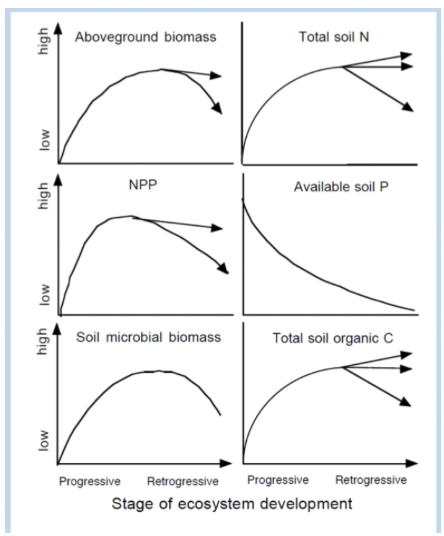
Franz Joseph chronosequence, N, C
In parent material, there is like no nitrogen but a lot of phosphorus (apatite)
When the surfaces start, high levels of available P
But plants and microbes can overcome this as the bacteria can fix N and then plants can use that (Increase in N fixation)
As plants develop, primary production increases, get more microbes growing, organic matter coming back into the system.
As the forest develops
N is increasing
P is decreasing
C increases and decreases, but end up with an overall increase
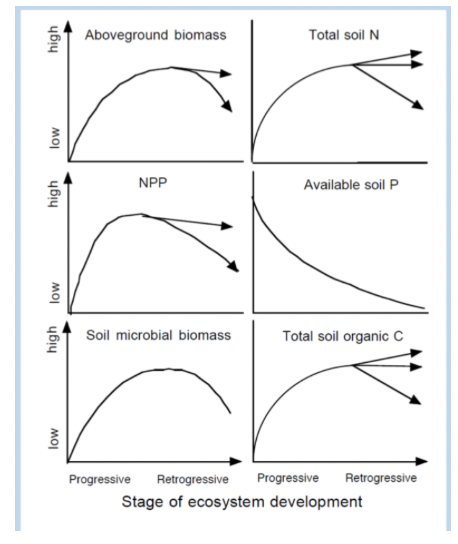
Franz Joseph chronosequence P
Get plants growing and that the total P declines (some into biomass, losing P in drainage)
Getting weathering occurring- release P and get aluminium and iron oxides- get P adsorption- retains P. With time becomes less available due to the Fe and Al oxides.
Inorganic P that is present isn't available to plants
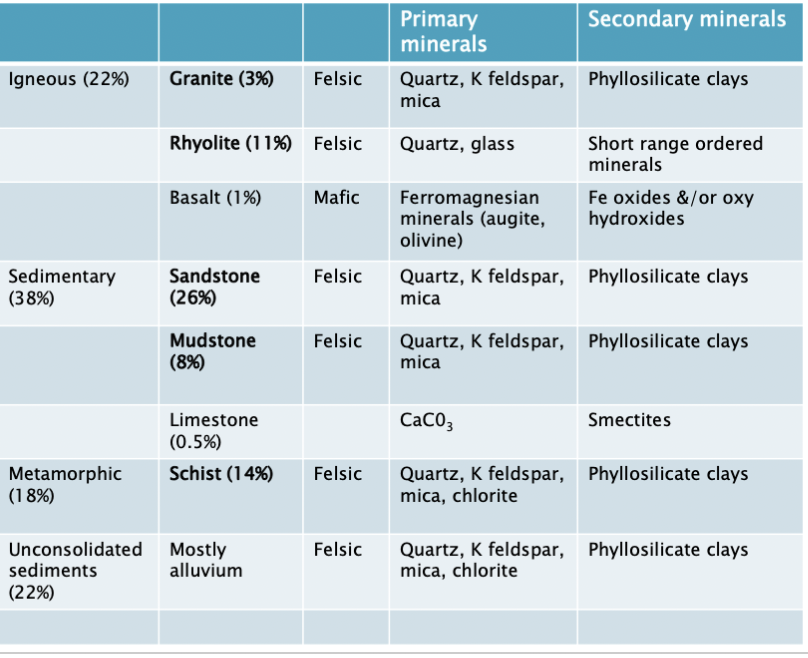
Common NZ rock types
e.g. granite vs basalt
a basalt PM will have a higher amount of nutrients to start with = differences in fertility due to mineral composition
Volcanic Rocks: Volcanic ash and lava flows, particularly from the central North Island’s volcanic activity. which are highly fertile, well-draining, and rich in minerals like phosphorus and silica. These soils are excellent for agriculture but can become acidic over time due to high rainfall and leaching.
Sedimentary Rocks: Sedimentary rocks such as limestone, sandstone, and mudstone give rise to soils like Pallic Soils and Brown Soils. Limestone-derived soils are often rich in calcium and have better natural fertility, while sandstone and mudstone produce less fertile, more acidic soils due to limited nutrient content.
Metamorphic Rocks: Schist and greywacke, common in the Southern Alps and eastern regions, weather into shallow, stony soils like Skeletals and Orthic Brown Soils. These soils are well-drained but generally low in fertility and prone to erosion, particularly on steep slopes.
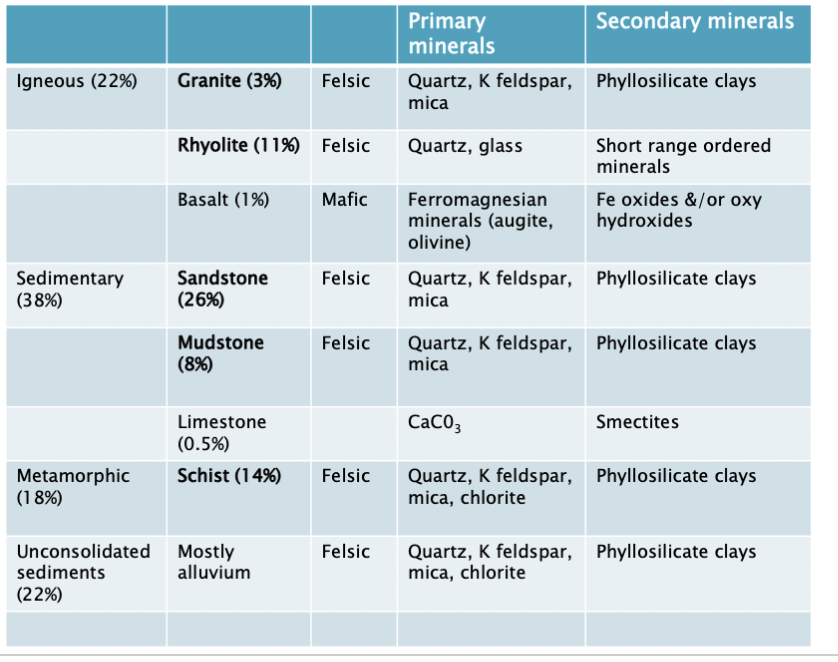
different forms of parent material and soil formation
Alluvial deposition: This occurs when rivers or streams transport and deposit sediments such as sand, silt, and clay in floodplains, riverbanks, and deltas. Alluvial soils are typically fertile due to the fine particles and organic material carried by water.
Loess: Wind transports and deposits fine silt particles, creating extensive loess plains. Well-drained soils with a crumbly texture.Often nutrient-poor.
Sand dunes: Sand particles accumulate due to wind action, typically in arid regions. Well-sorted sands that form various shapes, such as linear and crescent dunes. nutrient-poor and well-drained.
Till: Glaciers transport and deposit a mix of materials (till) ranging from fine particles to large boulders as they advance and retreat. Glacial soils are highly variable, often consisting of unsorted sediments, and can be fertile depending on their mineral composition
colluvium: transported down slope by gravity, Composed of anglular mix of particle sizes, is often poorly sorted. Fertility varies significantly, depending on the organic matter and nutrients from surrounding materials, but depth and drainage can influence agricultural potential.
how is soil colour, depth, stoniness, texture, structure and consistency described in the field
colour- Munsell colour chart, Based on Hue (dominant wavelength), value (brightness) and chroma (saturation)
Depth- Soil pit, soil augers, track/road cutting
stones- It can be quantified as a percentage of the soil volume that is occupied by stones.
texture- determined by the relative proportions of sand, silt, and clay. It can be assessed using the feel method (rubbing soil between fingers) or through laboratory analysis
structure- Observations are made on the size, shape, and degree of aggregation.
consistency- soil's physical state and resistance to deformation or rupture, assessed in different moisture conditions (dry, moist, and wet).
soil profile colours
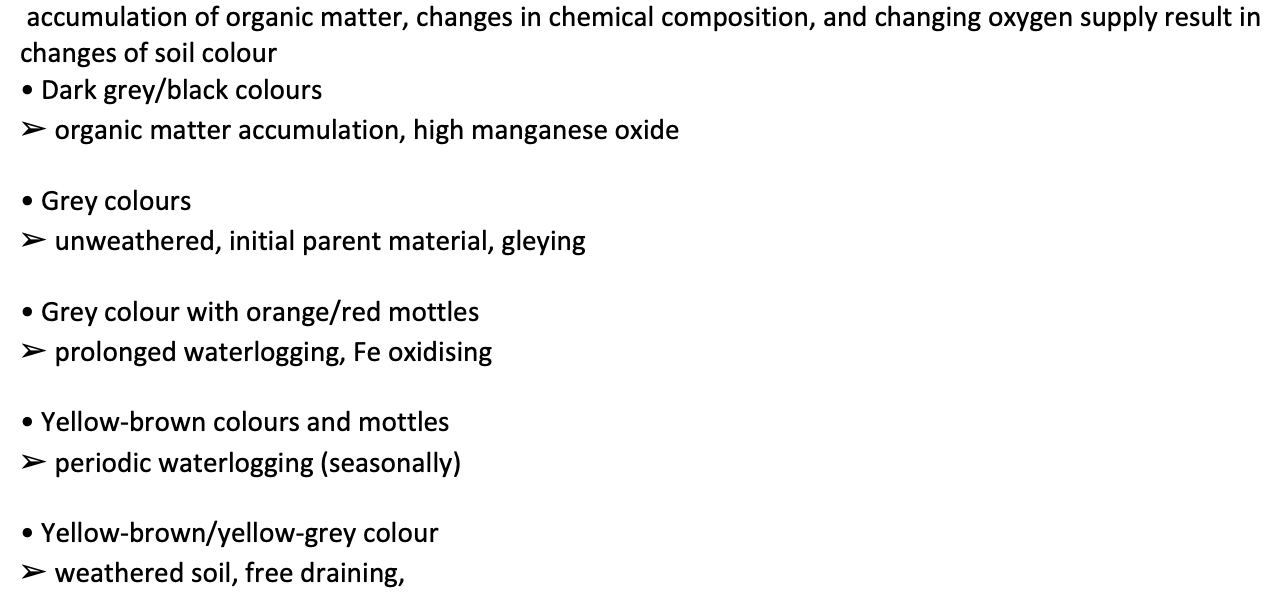
sizes of soil particles
SAND 2 mm to 20 microm (biggest particle)
Gritty, Can still see with the naked eye
ST: Provides good drainage and aeration, resulting in coarse-textured soil with low nutrient retention.
SILT 20 microm to 2 microm
Floury, Need a microscope
ST: Retains moisture and nutrients well, leading to a finer texture that supports better plant growth.
CLAY < 2 microm (smallest particle)
Sticky will need an electron microscope
ST= Excellent at holding water and nutrients but can lead to poor drainage and compaction in high clay soils.
how do soil aggregates form
MO- As microbes decompose organic matter, they release substances that promote aggregation.
OM- organic matter enhances soil structure by improving particle cohesion and creating a habitat for microorganisms that supports aggregation.
Clay- high surface area and charge, allowing them to attract and hold water and nutrients, which can help bind particles together.
benefits of soil aggregates for structure
bring soil particles together, creating larger units that provide stability. Helps prevent soil erosion and loss of topsoil.
Aggregates form pore spaces between them, which are essential for air and water movement. Improved pore space enhances soil aeration and drainage, allowing roots to access oxygen and moisture more effectively.
Aggregates provide a suitable environment for soil organisms, such as bacteria, fungi, and earthworms. The biological activity in and around aggregates contributes to organic matter decomposition and nutrient cycling, enhancing soil health.
Gravimetric Water Content
how much water is in the soil
θm=Mw/Ms (wet/dry mass)
volumetric water content
θv=Vw/Vt
Volumes of water over the total amount of soil
measuring soil water- Feel and appearance
➢ Take field samples and feel them by hand
◦ Advantages: cheap, easy to do, don’t need a lot of equipment, do it at multiple locations
◦ Disadvantages: might not be that accurate, need lots of experience
measuring soil water- neutron probe
Has fancy electronics and a counter
In the box, there are some elements which decay and emit particles, which collide with Be in the box, when the collide they emit very fast neutrons, which are then released into the surrounding soil sample, and they collide with hydrogen molecules in the water in the soil- the detector will measure the slowed-down neutrons.
Use an access tube- needs to be installed
Can be used in frozen conditions
More expensive
Disadvantages: expensive, radioactive source- needs declaration and needs a trained operator, the area covered depends on moisture content more- lots of nutrients will report back to the detector quickly thus less area covered, needs to be calibrated
measuring soil water- Time domain reflectometry
Cable testers, stuck into soil measures electromagnetic signals emitted into the soil via probes, which are reflected back to the source, the time taken to reflect back to the source depends on soil moisture.
Cant use in frozen soil, as ice and mineral values are very similar
Advantages
Non-destructive
Non-radioactive
Quite fast
Accurate
Don’t need to calibrate
Clear boundary
Potential to be multi purpose and automation
Disadvantages
Gap between rod and soil (if have shirking and swelling clays)
Installation and shrinking
Salinity issues
High EC in soil
measuring soil water- aquaflex
Electrical pulses travel along the cable and are slowed by soil water
Aquaflex measures a large volume of water content of ~ 6 litres of soil
1 at 5-30cm depth
And one lower e.g. 60cm deep
moisture tenison
Matric suction-
The suction created by small soil pores is greater than that created by large soil pores.
Smaller the diameter, the higher the forces holding the water in the tube
Not due to gravity as the forces aren't strong enough
Adsorbed water attached to the soil colloid
measuring soil moisture tension
TENSIOMETER
▪ Measuring the negative pressure, or tension, of water in soil in situ;
Composed of porous, permeable ceramic cup, a tube to a manometer or vacuum gauge.
Allows us to measure how strong the other spaces in soil- There is a lower potential with air inside it
Advantages
‒ Inexpensive
‒ Works well in saturated range
Easy to install and maintain
‒ Can operate for extended periods
‒ Data logger compatible
Disadvantages
‒ Difficult to translate data into water volume content
‒ Requires regular maintenance
‒ Subject to breakage
‒ Automated system costly
‒ Limited range
contact issues
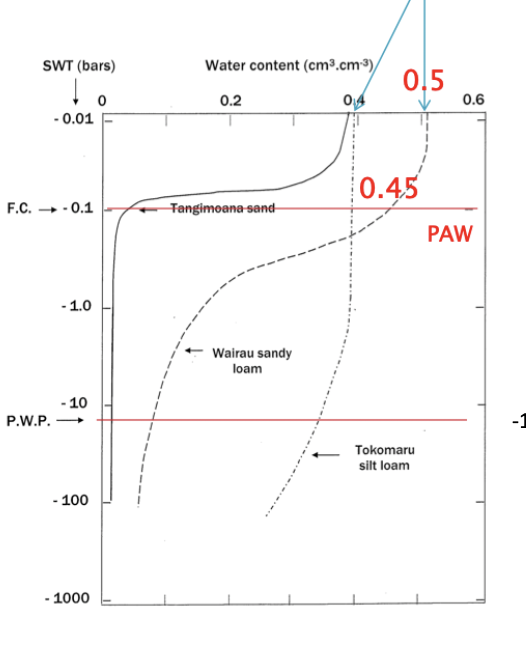
moisture characteristic curve and tensiometer
Need to relate tension to volumetric water content to know available water
SWT= -0.01 bars
FC= -0.1 Bars
PWP= -15 bars
Between SWT and FC= Macropores
Between FC and PWP= Medium sized pores
Below PWP= micropores
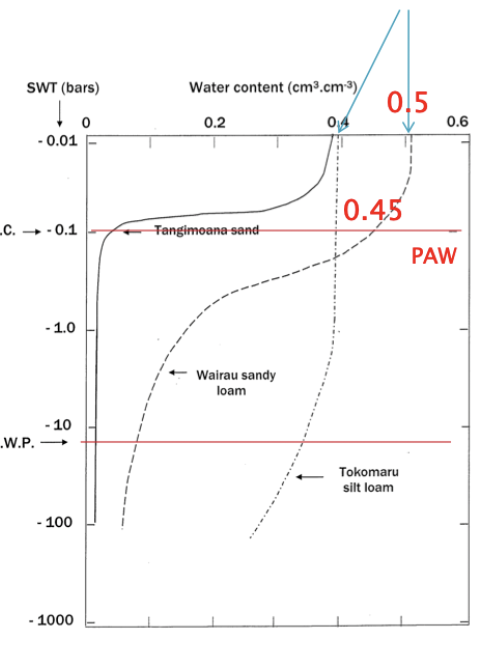
Saturation
0 to –10 kPa
Water held in macropores will drain freely from the soil
Field Capacity
available to plants
– 10 kPa
Stress point
between FC and PWP
less readily available to plants
species dependant
Permanent Wilting Point
–1500 kPa
Wilt point= All medium and macro pores are empty, plants don’t have enough power to suck out water from the micropores
Water calculations
Available Water Content (AWC)
=SWC (FC)-SWC (PWP)
Readily available water (RAW)
= SWC (FC) - SWC (SP)
soil water balance calculation
W1 + Change in W= W2
Change in W= P - ( R + DD + E)
P= precipitation
R= runoff
D= deep drainage
E= evapotranspiration
global and seasonal variation
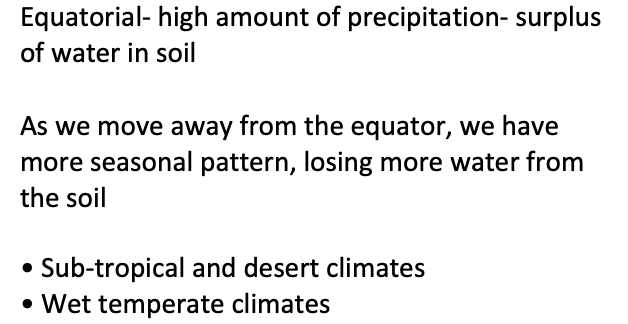
Winter= lots of rain, evapotranspiration isn't that large
Summer= less rain, evapotranspiration is higher
key soil properties that control soil PAW and RAW
Soil Texture:
sand retain less water, leading to lower PAW and RAW.
clays retain more water, increasing both PAW and RAW.
Soil Structure:
Well-structured soils improve pore connectivity, enhancing water retention and movement.
Poor structure can cause compaction, reducing PAW and RAW.
Pore Size Distribution:
A mix of macro and micropores influences water retention.
Larger pores facilitate drainage, while smaller pores retain water for plants.
Soil Organic Matter (SOM):
Higher organic matter improves soil structure and water-holding capacity, increasing PAW and RAW.
Soil Bulk Density:
Lower bulk density typically indicates higher porosity, enhancing water retention.
Higher bulk density can restrict water movement, reducing PAW and RAW.
relationship between ASW and Plant productivity
Texture and structure influence water retention and drainage, with organic matter enhancing moisture retention.
Available soil water is crucial for plant growth, enabling photosynthesis and nutrient uptake.
dequate moisture promotes healthy growth, while insufficient water leads to drought stress, wilting, and reduced yields.
Different plants have varying water needs; deep-rooted species access water from deeper layers, while shallow-rooted species depend on surface moisture.
Effective irrigation and crop selection based on water requirements can optimize agricultural yields and sustainability.- irrigation scheduling
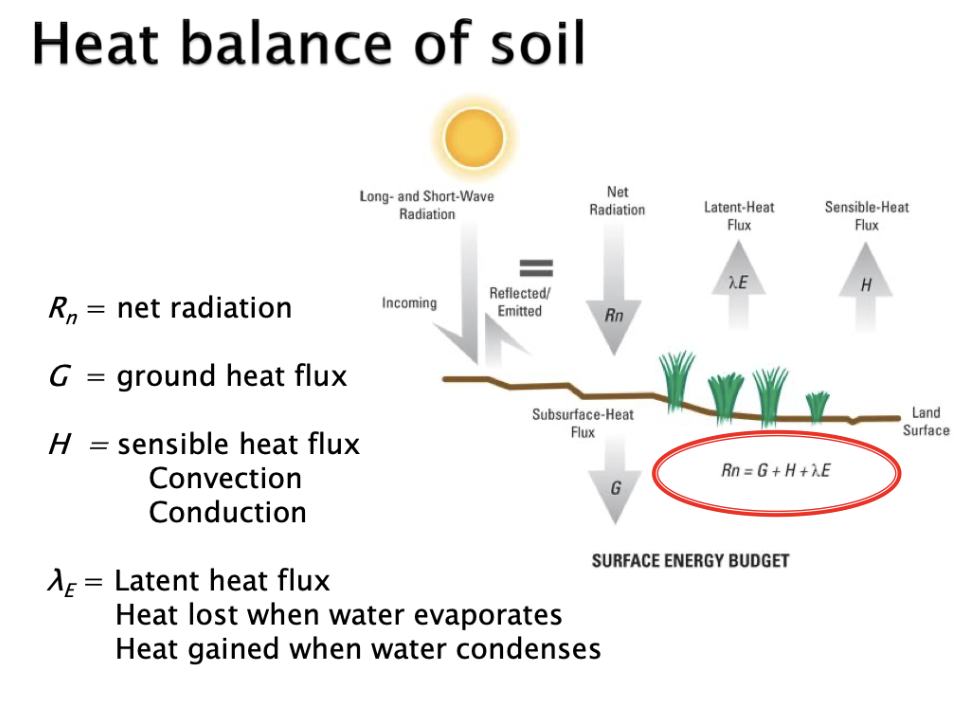
heat balance in soil
Radiation in = radiation out
Subtracting heat that is emitted from the atmosphere= net radiation- form of input into the soil
G= heat is transferred from top soil to deeper soil layers
Sensible heat flux= through soil profile and convection- loss from soil system
Latent heat flux- heat loss when something evapourates or gained when water condenses
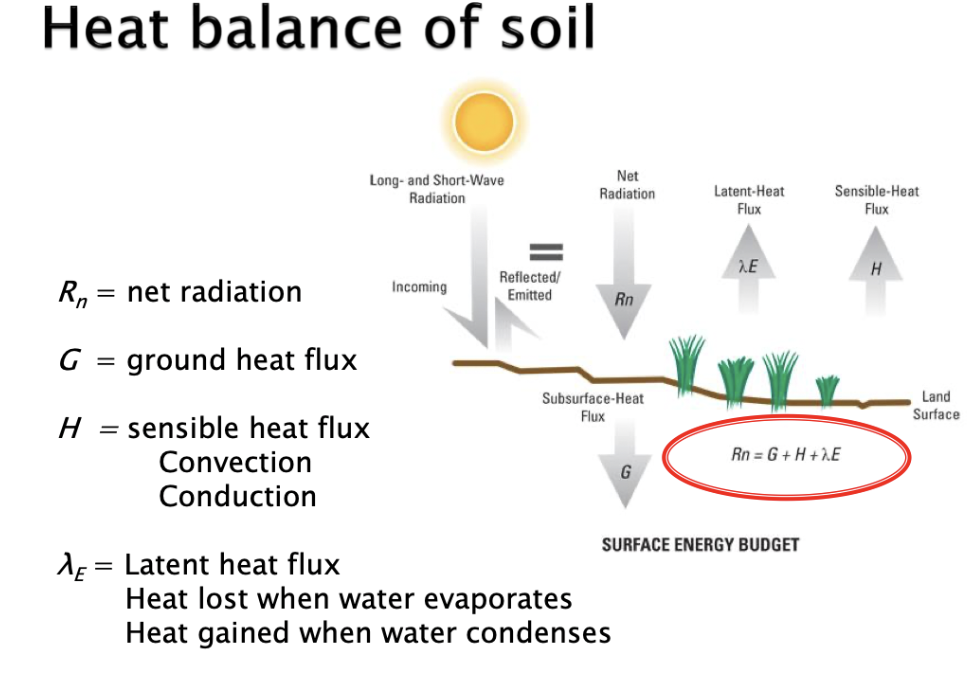
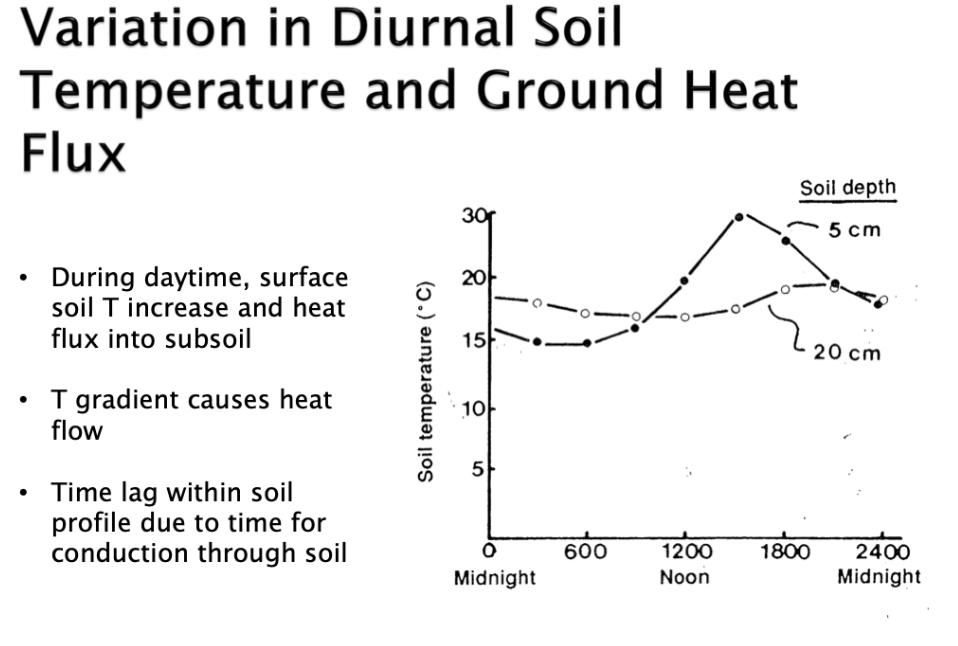
depth of soil and temperature daily
5cm-@9, sun starts to warm up top soil until afternoon/early evening, then as less radiation comes in and the soil cools
20cm- not in immediate contact with sunlight so don’t get the same amount of radiation, doesn’t change that much in temperature. But when the top soil warming up, the ground heat transfer occurs and warms up the sub soil (lagged behind by about 8-12 hrs) by the time the top soil is cooling, the sub soil will be warming up
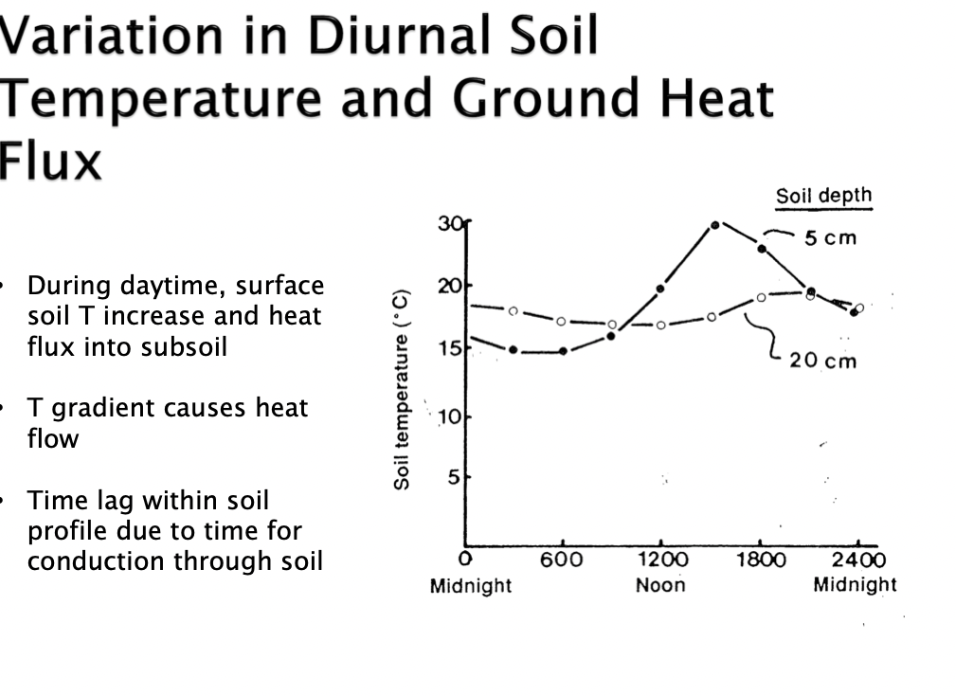
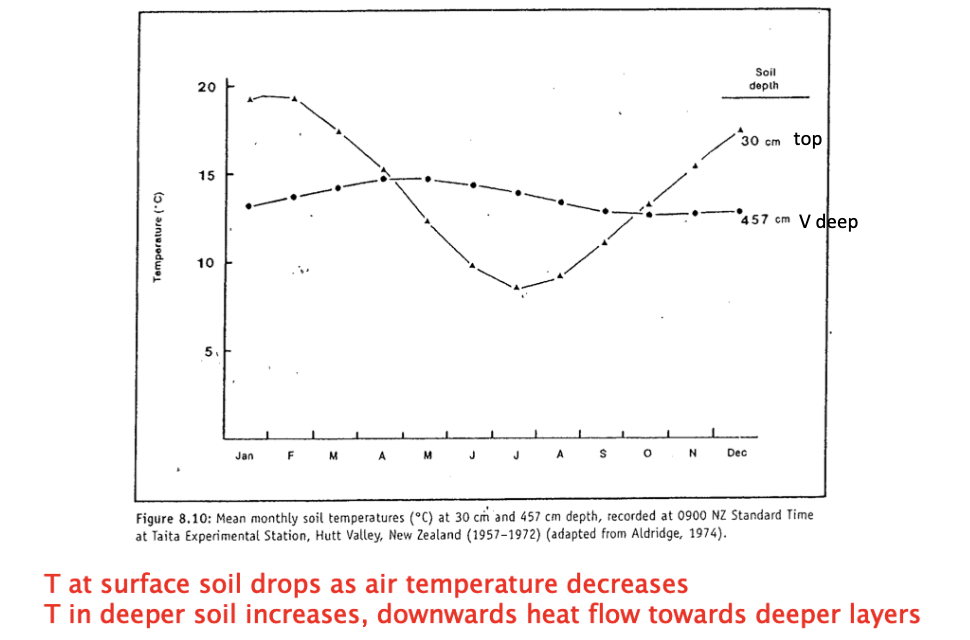
depth of soil and temperature seasonally
Summer= high temp, top soil warming up a bit
Winter= less radiation so soil doesn’t warm up that much
Losing heat with top soil, the time delay causes the sub soils to be heated up and as the sub soil is transferring heat back to the top soil layers- losing some degrees in the subsoil until the top soil starts heating up
T at surface soil drops as air temperature decreases
T in deeper soil increases, downwards heat flow towards deeper layers
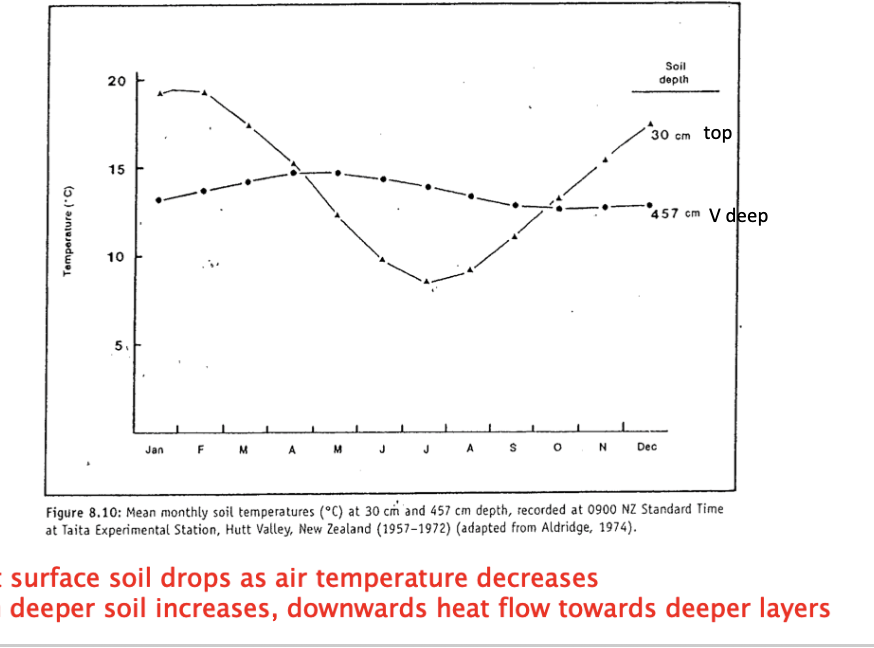

soil growing degree days
Measure of heat accumulation for plant development e.g. until a crop will reach maturity
Crop Scheduling: Helps determine optimal planting and harvest times based on temperature for maximum growth.
Irrigation Management: Indicates critical growth stages that require more water, aiding in effective irrigation planning.
Guides the timing of fertilizer applications to align with plant nutrient needs.

soil temp and soil respiration
Soil temp is related to microbial activity
Warm= act faster, start eating up organic material more, which means that more nutrients are released. = Higher amount of mineralisation
Mineral soil in a cool temperate conifer forest
Mineral soil, not a lot of organic matter
Cooler soil temp
Only slight increase in CO2 as there are less microbes present
Forest floor material in conifer forest
More CO2 respired
Increase temp, microbes act faster and faster
factors that determine soil aeration
Soil Texture: Coarser soils (like sandy soils) allow better air movement, while fine-textured soils (like clay) can reduce aeration due to smaller pores.
Soil Structure: Well-aggregated soils improve aeration, while compaction reduces it by limiting pore space.
Soil Moisture: Excessive water fills pore spaces, reducing air movement, whereas well-drained soils maintain good aeration.
Organic Matter: Enhances soil structure and increases pore space, improving aeration.
Root Activity: Plant roots create pathways for air, enhancing soil aeration.
Temperature: Warmer soils improve gas exchange; cooler soils reduce it.
Tillage: Can improve aeration temporarily but may degrade soil structure over time if overused.
Vegetation Cover: Maintains soil structure, while bare soils are prone to compaction and poor aeration.
aggregate stability
Plays a role in soil structure
Primary soil particles aggregate into larger units
Naturally occurring structural unit= ped
Structural unit as a result of cultivation = clod
Stability of aggregates depends on
Iron and Mg oxides
Humus- decomposing organic matter
Clay minerals- amount and type, -ve charge
Which +ve ions are present
aggregate breakdown
Slaking’= the tendency to break down into a pile of smaller aggregates.
‘Dispersion’= the tendency to release clay in the form of a milky cloud around the aggregate
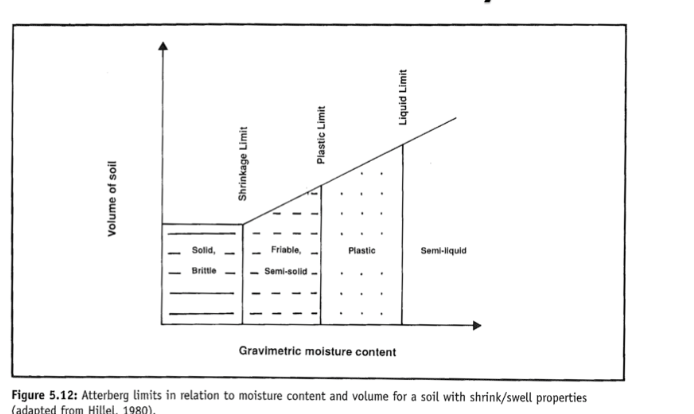
Measure of the ability for soil to withstand deformation and rupture
Solid- no water in soil, nothing happens up to a limit, as just mineral soil. Once reach the limit, soil volume will increase as water has been introduced, up until the plastic limit.
Plastic limit- describes the minimum amount of water which can be held by the soil, but puddling is still occurring. Left, max amount of water soil can hold when they are friable.
Not very good to till soil or drive soils when you have reached the plastic limit as you will destroy the soil structure
Liquid limit= change from plastic to behaving as a viscous liquid
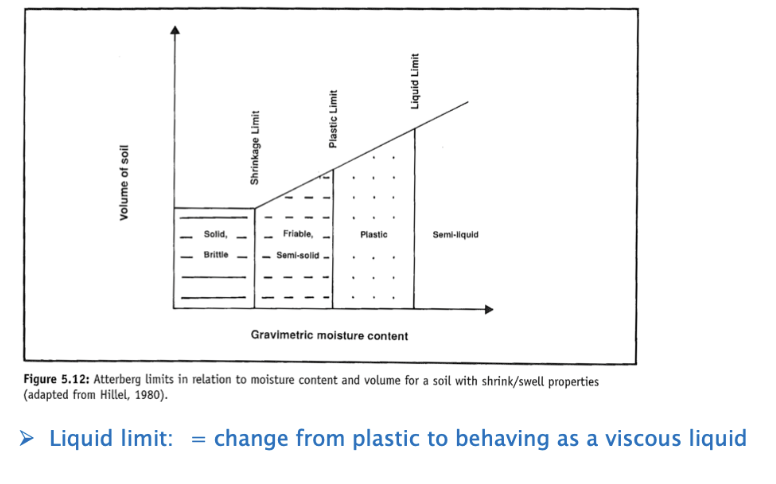
pan
Strongly compacted, indurated (hard) soil horizon
Naturally occurring
pans can form due to
Fragipan (silt )- Moderate levels of rainfall
Physical pressure from machinery, livestock, or foot traffic compresses soil particles, leading to a dense, hard layer.
High clay content allows particles to pack tightly, and poorly aggregated soil can contribute to pan formation.
restrict root growth and water movement
pan-busting
Break up hard pan layers and create spaces for roots to grow and water to run through the pans
Don’t change a lot from the top soil, don’t want to destroy too many of the aggregates
Deep ripping effects on soil
Increased infiltration
E.g. going from 1mm/hr to 27mm/hr via subsoiling for a clay soil
Goes from 200mm/hr to 150mm/hr via subsoiling with a silt loam soil
Improved clay is very important as it means it will accept irrigation water more easily
Improved root growth
Deeper roots can pick up more nutrients and water from the soil
Break up aggregates so nutrients are becoming more mobile in the soil
Want to make sure that all the nutrients wont be lost
Soil Constituents Involved in Cation Retention
Clay Minerals: Clay particles have negatively charged surfaces that attract and retain cations. Different types of clays (e.g., smectite, vermiculite) have varying abilities to hold cations due to their specific surface charges and structure.
Organic Matter: Humus, a highly decomposed organic material, has a large number of negative charges that can bind to cations, making it important for nutrient retention in soils.
Oxides of Iron and Aluminum: In acidic soils, oxides of iron and aluminum can also contribute to cation retention by providing negatively charged surfaces.
Silicate Minerals: Certain silicate minerals in the soil can contribute to cation retention through their surface charges.
cation exchnage capacity
the number of -vely charged sites present which are occupied by cations
Cation exchange
Cation exchange is where cations in the soil solution are exchanged with those held on the negatively charged surfaces of soil particles.
Adsorption: Negatively charged soil particles (clay, organic matter) attract and hold positively charged ions (e.g., Ca²⁺, K⁺, Mg²⁺) through electrostatic attraction.
Exchange: Cations in the soil solution can replace those adsorbed to soil particles. This exchange is typically based on the concentration of cations in the soil solution and their valency (higher-valency cations are more tightly held).
Equilibrium: A dynamic equilibrium exists between the cations in the soil solution and those adsorbed to soil particles. Cations are continually exchanged, allowing plants to access nutrients as they take up cations from the soil solution
factors that affect cation exchange
Concentration of Cations in Solution: A higher concentration of a particular cation in the soil solution increases the likelihood of it being adsorbed onto the soil particles through exchange.
Cation Charge: Cations with higher valence charges (e.g., Ca²⁺, Mg²⁺) are more strongly attracted to soil particles than those with lower valence (e.g., Na⁺, K⁺).
Cation Size: Smaller cations tend to be more tightly held by soil particles. However, larger cations (such as potassium) can be more easily exchanged.
Soil pH: As pH increases, more negatively charged sites are available for cation retention, enhancing the soil’s ability to hold and exchange cations.
Ionic Strength: The total concentration of ions in the soil solution affects the exchange process. Higher ionic strength can suppress cation adsorption.
phosphate on mineral surfaces- adsorption
Phosphate is held in soil, not anion exchange, it is held by specific adsorption.
Oxides adsorb the phosphate
Main mechanism= adsorption
E.g. Iron hydroxide surface, at the surface the phosphate can kick off the OH and replace it (ligand exchange). So, it becomes part of the surface. It is a reversible process when phosphate conc. goes down, the plant can take up phosphate and then back into the soil solution. Phosphate goes from replacing 1 hydroxide to 2 hydroxides, connected at 2 points so is less reversible. Starts to move into the surface and is less easily reversible and more stable.
Phosphate moves in a layer- solvent state diffusion, very stable
phosphate occlusion
occlusion: Things that are specifically adsorbed are coated by layers of occluding material such as Fe or Al oxides
Physical separation of the soil solution and chemical that you are interested in, e.g. P isn’t available
changes in P during soil development
In parent material, there is like no nitrogen but a lot of phosphorus (apatite)
When the surfaces start, high levels of available P
Very little inputs of Phosphate into the soil naturally, thus with time available P declines over time, due to uptake into biomass, P leaching due to rainfall (drainage). Available P starts to decline, then get a system which moves into P defiency, microbial biomass and soil organic C will start to decline
Get plants growing and that the total P declines (some into biomass, losing P in drainage)
Getting weathering occurring- release P and get aluminum and iron oxides- get P adsorption- retains P. With time becomes less available due to the Fe and Al oxides.
Inorganic P that is present isn't available to plants
changes in N during soil development
at the start there are low levels of N, But plants and microbes can overcome this as the bacteria can fix N and then plants can use that (Increase in N fixation)
As the forest develops= N is increasing
Soil acidity develops due to several key factors
Parent Material: Soils derived from acidic rocks (like granite) tend to be more acidic.
Rainfall and Leaching: High rainfall leaches away base cations (calcium, magnesium) and leaves behind acidic ions, increasing acidity.
Decomposition of Organic Matter: Organic matter breakdown releases acids, contributing to soil acidification.
Plant Root Activity: Roots release hydrogen ions during nutrient uptake, promoting acidity.
Fertilizer Use: Nitrogen-based fertilizers, especially ammonium-based ones, increase soil acidity.
Acid Rain: Industrial emissions cause acid rain, which lowers soil pH.
Crop Removal: Harvesting crops depletes base cations, leading to more acidic soil.
Soil Type: Sandy soils acidify faster due to lower buffering capacity, while clay soils resist acidification.
Weathering of Minerals: Chemical weathering of minerals releases hydrogen ions.
Land Management Practices: Deforestation, overgrazing, and intensive farming can accelerate acidification
soil as a buffer
Soils buffer pH changes through their cation exchange capacity (CEC), organic matter, and the presence of carbonates. Cations like calcium and magnesium can replace hydrogen ions to neutralize acidity, while organic matter and carbonates help moderate pH shifts.
soil and neutral salts e.g. NaCl
When neutral salts are added to soil, they can displace cations like hydrogen from soil particles, which may increase acidity. Salts also affect ion activity in the soil solution, potentially altering pH indirectly. High sodium levels from salts can also damage soil structure, leading to further pH changes over time.
Plant-microbe-soil interactions in the rhizosphere
Microbial Communities: The rhizosphere hosts diverse microbes, including beneficial bacteria and fungi that promote plant growth, nutrient availability, and disease suppression.
Nutrient Cycling: Microbes play a key role in nutrient cycling, such as nitrogen fixation by Rhizobium, phosphate solubilization by mycorrhizal fungi, and organic matter decomposition, releasing nutrients for plant uptake.
Root Exudates: Plants release organic compounds into the rhizosphere, which attract beneficial microbes, enhance nutrient availability, and detoxify harmful substances.
Mycorrhizal Associations: Mycorrhizal fungi form symbiotic relationships with plants, improving nutrient and water absorption and enhancing resistance to pathogens and drought.
Soil Structure and Health: Microbial activities contribute to soil aggregation, improving structure, aeration, and resilience, which benefits root penetration and water infiltration.
Feedback Loops: Interactions create feedback loops, where plant health influences microbial communities, affecting nutrient availability and overall soil properties.
microflora
Breakdown organic matter to release energy and nutrients
e.g. bacteria
They break down organic matter coming into the soils
Bacteria cant move towards C sources that are far away
Fungi can send out hyphae "move'' towards resources
microfauna
Feed on microflora and microfauna
e.g. protozoa
Predate on other bacteria
mesofauna
Feed on fungi and microfauna. Fragment and incorporate organic matter e.g. nematodes, mites and insects
Macrofauna
fragment and incorporate organic matter and mix topsoil
e.g. earthworm
Break down organic matter and mix it into the soil, makes it lot accessible to bacteria and more available to fungi



Bacteria and fungi, when they get C, they are getting energy for themselves, competing with plants
Releases nutrients from the bacteria and fungal population, beneficial for plant if has a root near the soil water
Plants and mycorrhizal fungi interact in the rhizosphere to enhance soil nutrient availability and acquisition
Symbiotic Relationships: Mycorrhizal fungi form partnerships with plant roots, where plants provide carbohydrates and fungi improve nutrient and water uptake.
Enhanced Nutrient Uptake:
Fungi increase the root system's surface area through hyphal networks, allowing greater absorption of nutrients.
They mobilize essential nutrients, particularly phosphorus and micronutrients, making them available for plant use.
Soil Structure and Health:
Mycorrhizal fungi promote soil aggregation, improving aeration, water infiltration, and root penetration.
They aid in the decomposition of organic matter, enhancing soil fertility.
Plant Growth Promotion:
Fungi can produce hormones that stimulate root growth and enhance plant resilience to environmental stresses, improving nutrient uptake.
Microbial Interactions:
Mycorrhizae can outcompete pathogens, leading to healthier roots and better nutrient acquisition, while also promoting beneficial microbial activity in the rhizosphere.
Dynamic Nutrient Cycling:
Root exudates from plants can enhance microbial activity, creating a continuous cycle of nutrient availability.
different types of litter produced by forest and grasslands and how this affects soil formation
Forest Litter:
Composed of fallen leaves, twigs, branches, bark, and fruits.
Contains slow-decomposing materials, especially from coniferous trees, which can lead to greater organic matter accumulation and more acidic soil.
Grassland Litter:
Primarily consists of grass blades, seeds, and roots.
Decomposes rapidly due to higher nitrogen content, contributing to nutrient cycling and soil structure.
Effects on Soil Formation
Nutrient Cycling:
Decomposition releases essential nutrients (N, P, K) back into the soil, enhancing plant growth and microbial activity.
Organic Matter Accumulation:
Litter is a primary source of soil organic matter, leading to humus formation, which improves soil structure and nutrient retention.
Soil Structure:
Contributes to soil aggregation, improving aeration, drainage, and root penetration.
Soil Horizons:
Promotes the development of a thick O horizon (organic layer) in forests and enriches the A horizon, characterized by high organic content.
differences between soils under pasture and pine plantations
Forest
large canopy volume = umbrella effect → decrease in erosion
litter fall → increase in OM
mycorrhizal association
light leaching → uptake via deep roots
favourable microclimate
little loss from system
Agricultural
no/little canopy volume → severe erosion and nutrients are un-intercepted in rainfall
low litter fall → little foliage leaching
fertilser input
large export of nutrients and erosion when harvested
surface accumulation of roots
heavy leaching
heavy loss from system
implications for conversion- pasture and pine plantation soils
Implications for Conversion Converting Pasture to Pine: Requires soil amendments (lime, fertilizers) to address acidity and nutrient levels. Increased erosion risk during establishment. Converting Pine to Pasture: Soil may need recovery time from acidic conditions; organic amendments may help. Nutrient restoration through fertilization is often necessary. Long-term Management: Ongoing monitoring of soil health indicators (pH, organic matter) is essential. Sustainable practices (crop rotation, cover cropping) can enhance soil quality in both systems
Land-Use Changes and Effects on Soils
Planting Pine on Low-Fertility Soils:
Pine trees were planted on shallow, stony soils with little topsoil, as these trees can grow well in low-fertility soils.
Flat land was ideal for planting pine due to ease of harvesting.
Irrigation and Conversion to Pasture:
Irrigated land became more fertile, allowing for grass growth and conversion to grazing land for cows.
Post-Harvest Practices:
After cutting down the pine trees, the stumps were removed and burned.
Mulchers were used to break up remaining wood debris.
Soil Amendments:
To support pasture growth, lime was added to increase the soil pH and lower the carbon-to-nitrogen (C
) ratio.
Fertilizers containing phosphorus (P), sulfur (S), and nitrogen (N) were applied to improve soil fertility.
Biological Impact:
The soil environment was not initially conducive to biological activity, and pasture soils lacked earthworms, which are important for soil health.
Impact of Earthworms:
In areas where earthworms were introduced alongside fertilizer and lime, the mixing action of the earthworms improved soil structure and led to increased grass growth.
S
tudying the Effects of Land-Use Change on Soils:
This information highlights the potential methods for studying land-use changes on soils:
Soil Fertility: Comparing soils before and after amendments like lime and fertilizers can show changes in nutrient availability and pH.
Biological Activity: The presence or absence of earthworms and other soil organisms can indicate soil health, with potential studies on how their introduction improves soil structure and plant growth.
Carbon and Nitrogen Cycling: Investigating changes in the C
ratio and organic matter after converting pine plantation to pasture can provide insights into nutrient cycling in the soil.
Physical Soil Structure: Mulching, tree removal, and soil amendments can be studied for their impact on soil compaction, aeration, and water infiltration.
Long-Term Soil Health: Monitoring the soil over time, particularly in irrigated areas, would reveal how continuous fertilization and land-use conversion affect overall soil health and productivity.
process of organic residue decomposition
Organic residue decomposition in soil is the breakdown of plant and animal material by microorganisms, releasing nutrients essential for plant growth. It occurs in several stages:
Fragmentation: Soil organisms physically break down organic matter.
Leaching: Soluble compounds are washed into the soil and consumed by microbes.
Microbial Decomposition: Bacteria and fungi break down complex compounds like cellulose and proteins.
Humification: Some organic material forms humus, which improves soil structure.
Mineralization: Nutrients are converted into forms usable by plants.
Factors like moisture, temperature, soil pH, oxygen, and residue composition affect the decomposition rate, making it vital for nutrient cycling and soil health.
major types of biota found in the soil ecosystem
Bacteria= more than 1 billion in a gram of soil
Fungi= 10 million in a g of soil
Protozoa= 10 thousand in a g of soil
nematodes= 100 per g
NZ soil classification to identify soil properties
The New Zealand Soil Classification (NZSC) identifies soil properties by grouping soils based on characteristics like parent material, soil horizons, organic matter content, texture, drainage, and pH levels. This classification helps in understanding soil fertility, water retention, aeration, and suitability for land use, guiding decisions in agriculture, forestry, and conservation for sustainable management.
soil used for forestry
Ultic soils
Podzols
Ultic
northern North Island, and in the Wellington, Marlborough, and Nelson regions
Key SFF Parent material= quartz-rich rocks. Time = very old.
Soil properties: Soils are strongly acid with low nutrient reserves. Soils have a large and active population of soil organisms in topsoils. Clayey subsoils with slow permeability are characteristic. Soils have dispersible surface horizons susceptible to livestock treading damage, and are prone to erosion.
Podzols
areas of high rainfall and are usually associated with forest trees with an acid litter.
Key SFF PM=silica-rich rocks. Climate =high rainfall. Organisms.
Compacted B horizons are common, with slow permeability and limited root depth. E and B horizons are weakly pedal or lack pedality.Podzols have low natural fertility, low base saturation, and are strongly acid. Secondary oxides and other clay minerals are strongly differentiated with depth.Podzols have low biological activity. The vegetation comprises plants that deposit a mor-forming acid litter.
soil used for forestry
Brown
Allophanic
brown
occur in places where summer drought is uncommon and that are not waterlogged in winter.
SFF moderate to high rainfall and relatively mild temperatures. PM= limestone or sandstone volcanic ash, and loess.well-drained landscapes, including gentle slopes and flat areas where water does not accumulate excessively.
They have relatively stable topsoils with well-developed polyhedral or spheroidal structure. Soils have low to moderate base saturation. Soils contain large, active populations of soil organisms, particularly earthworms.
Allophanic
North Island volcanic ash and in the weathering products of other volcanic rocks. Weathering products of greywacke and schist in the South Island high country.
SFF PM= volcanic ash (tephra) and weathered volcanic rocks. moderate to high rainfall,volcanic plateaus, rolling hills, and valley floors
Because bulk density is low there is little resistance to root growth. Topsoils are stable and resist the impact of machinery or grazing animals in wet weather. Erosion rates are generally low except on steep slopes or exposed sites.
The ability to retain phosphorous is high. Natural fertility is low.
Soils contain large populations of soil organisms, particularly in A horizons.
soil used for forestry
pumice
pallic
pumice
central North Island, particularly in the Volcanic Plateau.
SFF dominated by pumice, natural glass.
They occur in tephras ranging from 700 to 3500 years old.
Clay contents are low, generally less than 10%. They have low soil strengths, high macroporosity, and deep rooting depth. Soils have low strength when disturbed, but are generally resistant to livestock treading damage. low reserves of major nutrient elements. Trace elements are likely to be deficient. Clay minerals are dominated by allophane.Soil animal populations are low. Earthworm populations are limited by droughtiness and coarse texture.
pallic
seasonally dry eastern part of the North and South Islands, and in the Manawatu.
SFF Dry climate, low contents of iron oxides. dry in summer and wet in winter
Soils have slow permeability with limited rooting depth, and medium to high bulk density. They are susceptible to erosion because of high potential for slaking and dispersion.Soils have medium to high nutrient content ( except for sulphur), high base saturation, low concentrations of secondary oxides, and low organic matter contents.Soils are strongly worm-mixed, at the boundary of the A and B horizons.
soil used for forestry
recent
raw
Recent soils
occur throughout New Zealand on young land surfaces
SFF Lack of time as less than 1000 to 2000 years old.
The soils have variable soil texture, with common stratification of contrasting materials, and spatial variability is high. They are generally deep rooting and have high plant-available water capacity.
Natural fertility is usually high with high base saturation. The clay mineralogy is usually dominated by illite.
A continuous cover of vascular plants is normally well established.
raw
scattered throughout New Zealand, particularly in association with high mountains (alpine rock areas and active screes), braided rivers, beaches and tidal estuaries
SFF time
Raw Soils have no B horizon, and a topsoil is either absent or less than 5 cm thick. Most occur in environments with active erosion or deposition. Fluid soils have a continuously high water-table.
Fertility is limited by lack of organic matter and nitrogen deficiency.
Vegetation cover is sparse and often consists of ephemeral herbaceous plants, mosses, or lichens.
soils not used for forestry
semiarid soils
gley soils
semiarid
inland basins of Otago and southern Canterbury NOT USED: too dry
SFF - CLIMATE :annual precipitation is less than about 500 mm.- PM: often develop on loess (wind-blown silt), alluvial deposits, or weathered rock from schist, greywacke, and limestone.
- high slaking and dispersion potential, and moderate to high bulk densities. Soil structure is usually weakly developed and the soils are erodible. low organic matter, cation exchange capacity and low iron and aluminium oxide contents. weakly buffered. low biological activity because of droughtiness and low organic matter contents.
gley soils
throughout New Zealand in low parts of the landscape where there are high groundwater-tables, or in places where there are seepages.
NOT USED: Waterlogged
SFF Climate: Waterlogging occurs in winter and spring, and some soils remain wet all year, Topography
high groundwater-tables, shallow potential rooting depth, and relatively high bulk density. Trafficability is limited when soils are wet. Drainage is necessary for most agricultural development. Soils have common segregated iron and manganese oxide mottles, concretions or nodules. Organic matter content is usually high.Many soil organisms are restricted because of anaerobic conditions.
soils not used for forestry
anthropic
oxidic
anthropic
Anthropic Soils were formed by gold dredging in Central Otago and Westland. NOT USED: man-made soil, will be near civilisation- wont grow forests |
SFF Time, PM= artificial materials such as mine spoil, dredged materials, and constructed land surfaces.mixing and compaction of soil materials
The relationships between Anthropic soils and landforms do not have the orderliness of natural soils. Soil properties depend on both the nature of the manufactured or natural materials, and the nature of the soil manipulation. Land surfaces are artificial and drainage has often been changed significantly from the original state.
oxidic
Auckland and Northland regions. NOT USED: not common, lack of nutrients, well structured
SFF PM: weathered andesite, dolerite or basalt rock or ash.Time- quite old
Soils have limited rooting depth, well-developed and relatively stable structure, slow permeability, and moderate or rapid infiltration rates. Clay contents are high, ranging from 50 to 90%. Soil water deficits are common in summer.
Oxidic soils are strongly weathered with low reserves of potassium, magnesium, calcium and phosphorus. Clays have low cation exchange capacity at the natural pH of the soil, and phosphate retention is high.
soils not used for forestry
melanic
granular
melanic
occupy small areas scattered throughout New Zealand, in association with lime-rich rocks or dark (basic) volcanic rocks. NOT USED: not abundant, other land uses- vineyards
SFF PM= contains lime, or has a well-developed structure and is neutral or only slightly acid.
The topsoil structure is usually stable. The soils shrink on drying and swell on wetting. Natural fertility is high. Base saturation is high with high exchangeable calcium or magnesium. The clay fraction is usually dominated by swelling (smectite) clays. These soils are biologically very active with high populations of soil organisms.
granular
northern North Island, particularly in the lowlands of the Waikato and South Auckland regions. NOT USED: not abundant, old soils= root barriers – imposes tree growth
SFF: PM strong weathering of volcanic rocks or ash. Time - older than 50 000 years.
The soils are slowly permeable and have limited rooting depth. Topsoils have limited workability when wet.Soils are strongly weathered with low nutrient reserves, and low phosphorus status and sulphate in B horizons. They are usually dominated by kaolin-group clay minerals, with some vermiculite.
soils not used for forestry
organic
wetlands in most parts of New Zealand, or under forests that produce acid litter in areas with high precipitation.
NOT USED: low bulk-density- cause trees to fall over in wind SFF= PM decomposed remains of wetland plants (peat) or forest litter, Organisms |
Organic Soils have very low bulk densities, low bearing strength, high shrinkage potential when dried, very low thermal conductivity and high total available-water capacity.
Organic Soils have high cation exchange capacities, are usually strongly or extremely acid, and nutrient deficiencies are common.
High carbon/nitrogen ratios indicate slow decomposition rates. Many soil organisms are restricted because of anaerobic conditions.
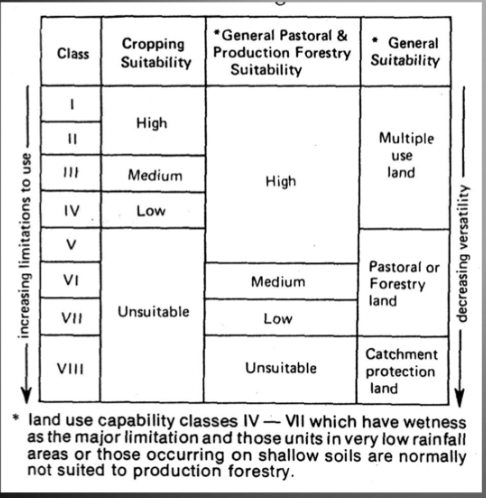
land use capability
subclass= dominant type of limitation
s= soil
w=wetness
e=erosion
c= climate
sS= soil slip erosion
Ef= earthflow erosion
g= gully erosion
Unit
= 1,2,3,4……
Different soil types
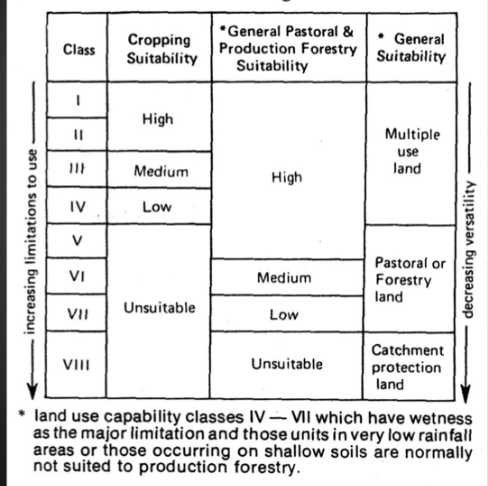
density and porosity equations
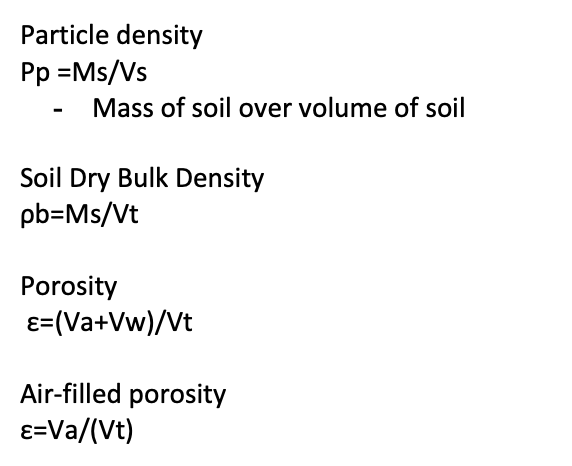
particle density= How much of soil minerals do we have over a certain volume, tells us about pore space. Higher the weight the less space there is for air and water
Air-filled porosity refers to the volume of air spaces, or pores, in soil that are not filled with water. allows roots to access oxygen and supports microbial activity. Low porosity can limit root function and growth.
Bulk density is the mass of soil per unit volume, indicator of soil compaction and soil structure. Higher bulk density indicates more compacted soil with fewer pore spaces, which can limit root growth, water infiltration, and air exchange.

variation due to the 5 SFF
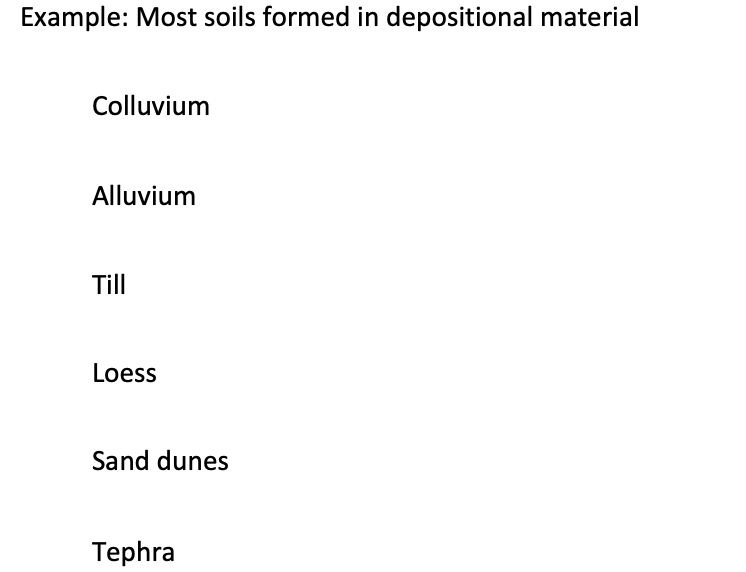

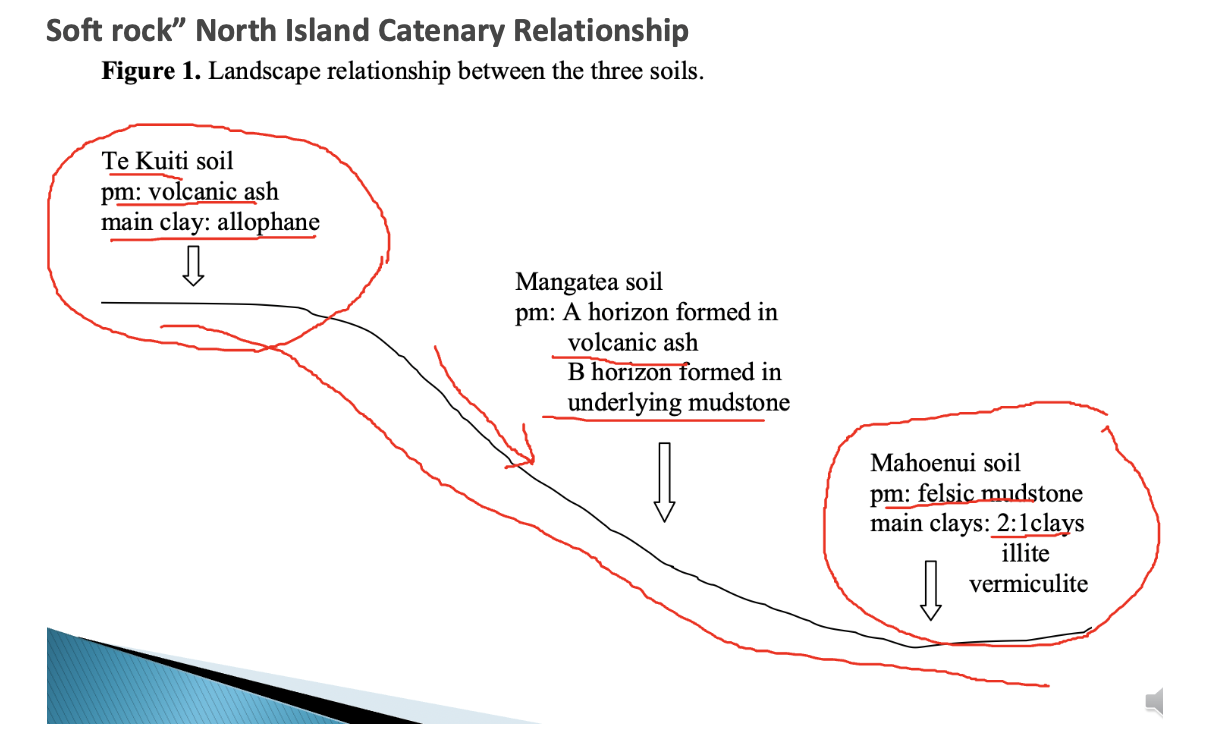
soft rock NI Catenary relationship
top= Te Kuti soil
ash over tephra
middle= mangatea soil
Forming from PM= A horizon formed in volcanic ash. B horizon formed in underlying mudstone
Recent soil order, Raw soil order
youngest due to erosion
bottom= mahoenui soil
PM= felsic mudstone
has alluvial material
Floods could deposit fine sediment = PM for soil formation
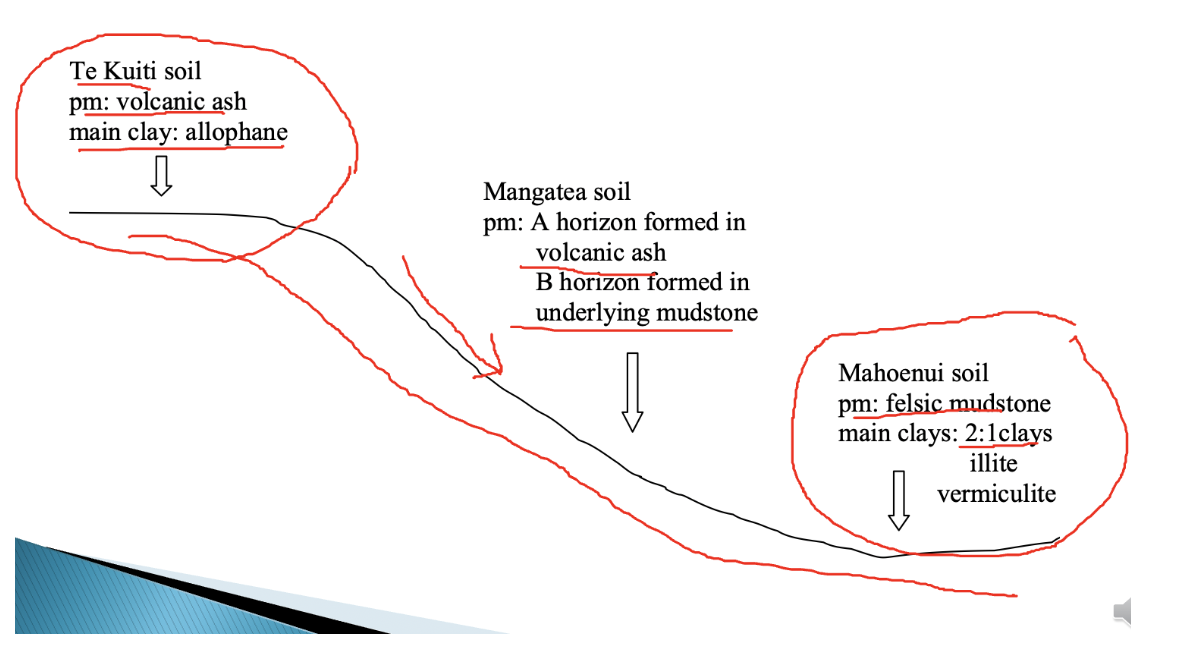
soil maps to identify soil properties
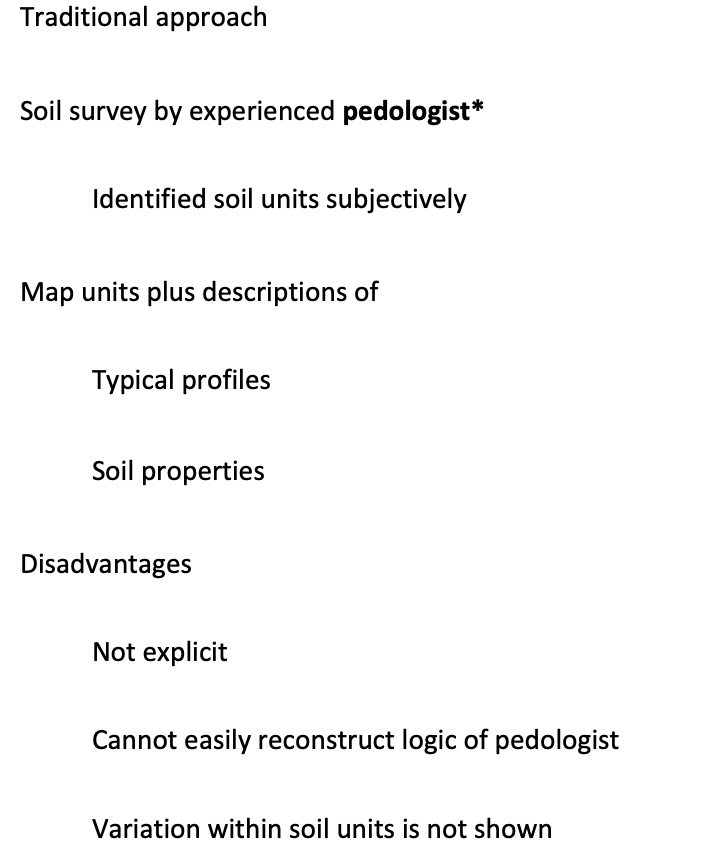
s-map
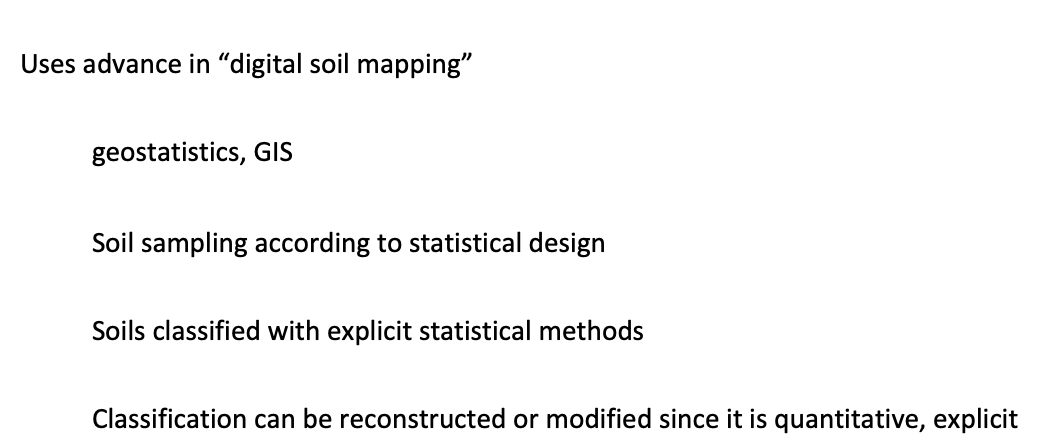

LUC- slope classification
A= flat = 0-3 deg
D= strongly rolling =16-20 deg
G=Very steep= greater than 35 deg
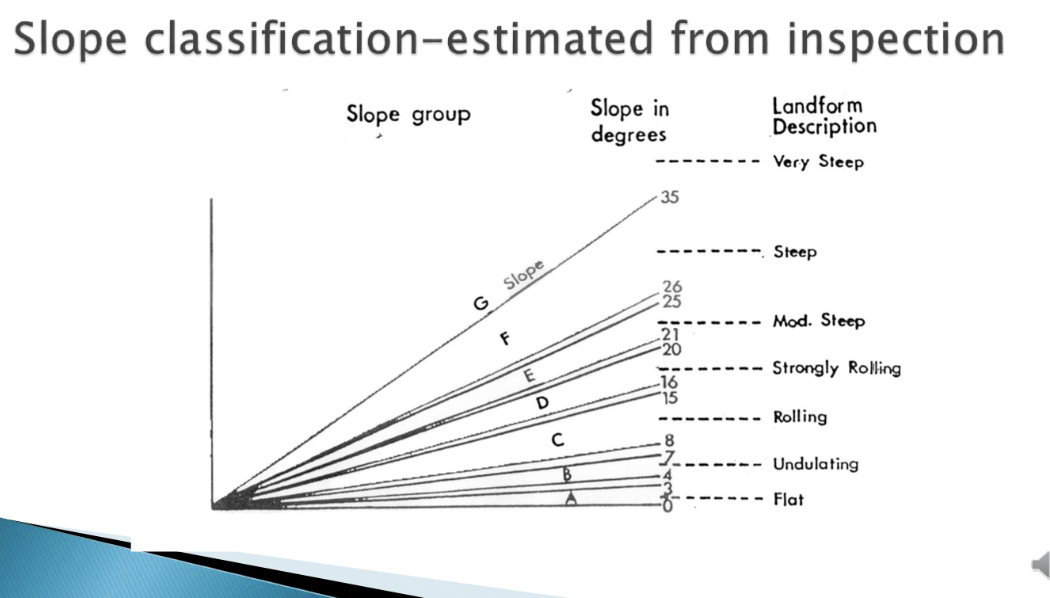
landslides and soil erosion affecting waterways
soil slip erosion (sS)= Thin layers of topsoil slide down slopes, reducing soil productivity.
Earthflow erosion (Ef)- soil flows as a liquid= Saturated soil flows like a liquid, removing large volumes of nutrient-rich soil.
gully erosion (G) - River cuts through making the slope 'over-steep' get collapsed material= Rivers cut deep channels, collapsing slopes and eroding valuable topsoil.
debris floods from clearfelling sites via a landslide= Landslides from clearfelling cause sediment to enter waterways, harming water quality.
decrease soil fertility and productivity while increasing sedimentation in waterways, negatively impacting water quality
explain how limitations to sustainable use are described and mapped by the NZLRI and LUC maps ( with respect to erosion)
The NZLRI (New Zealand Land Resource Inventory) and LUC (Land Use Capability) maps assess and describe limitations to sustainable land use, focusing on erosion risks. The NZLRI records physical land features like soil type, slope, and erosion risk, identifying areas prone to erosion.
The LUC classifies land into eight categories, with higher categories (LUC 6-8) indicating greater erosion risk and limitations for productive use. These maps guide land management decisions by showing where conservation or erosion control measures are needed to maintain sustainable land use.
bad effects forestry has on soil fertility and physical properties
Forestry can negatively impact soil fertility and physical properties by depleting nutrients through harvesting, increasing soil acidity (especially with pine plantations), and causing soil compaction from heavy machinery. Clearfelling exposes soil to erosion, while reduced organic matter and root loss disrupt soil structure, leading to poor aeration, decreased water infiltration, and increased runoff. These effects can result in long-term declines in soil fertility and productivity.
good effects forestry has on soil fertility and physical properties
Organic Matter Accumulation:
Trees contribute organic matter through leaf litter, branches, and roots, which improves soil structure, moisture retention, and nutrient cycling.
Erosion Control:
Tree roots stabilize the soil, reducing erosion risks by anchoring soil particles and minimizing surface runoff, particularly on sloped areas.
Soil Structure Improvement:
Trees' deep and extensive root systems enhance soil porosity, improving water infiltration, aeration, and root penetration for other plants.
Nutrient Cycling:
Deep-rooted trees bring nutrients up from deeper soil layers, which are then redistributed through leaf litter and decomposition, enriching the surface soil.
Carbon Sequestration:
Forest soils act as carbon sinks, improving soil health and fertility through organic matter buildup.
Umbrella Effect:
The tree canopy protects the soil from heavy rainfall, preventing surface erosion and compaction. It reduces the direct impact of raindrops, allowing water to infiltrate gradually, which helps maintain soil structure and fertilityHow forests prevent shallow landslides
Roots reinforce soil
Canopy intercepts and evaporates rainfall and pulls up soil moisture
The soil underneath remains drier- drier= stronger, increase the shear strength
The root depth of the tree is shallow, as most hill country soils are shallow
Reduce rates of shallow landslides
Slowing earthflow movements down
Reducing rates of gullying
Reducing rainfall-induced landslides
discusss the meaning of soil quality and indicator variables for soil productivity
Soil Organic Matter (SOM) – enhances fertility, structure, and water retention.
Soil pH – affects nutrient availability and microbial activity.
Soil Texture – influences water retention, drainage, and nutrient capacity.
Soil Structure – determines aeration, water movement, and root growth.
Cation Exchange Capacity (CEC) – indicates nutrient retention ability.
Bulk Density – measures soil compaction, affecting root growth and infiltration.
Water Holding Capacity – important for drought resilience.
Microbial Activity – reflects nutrient cycling and soil health.
Olsen P is a measure of the plant-available phosphorus (P) in soil.
Soil indicator variables are measured in both field and lab settings
Soil Organic Matter (SOM): Measured in the lab using loss on ignition (heating soil to burn organic matter). In the field, it can be estimated by observing soil color.
Soil pH: Measured with pH meters or test strips in the field, and more precisely in the lab with a glass electrode pH meter.
Soil Texture: Estimated by feel in the field (sand feels gritty, clay sticky). In the lab, a particle size analysis is used with sieving and sedimentation.
Cation Exchange Capacity (CEC): Lab analysis with ion displacement and spectroscopy.
Bulk Density: Measured by taking soil cores in the field and weighing them after drying in the lab.
Water Holding Capacity: Field sensors can estimate moisture, and lab tests measure water retained at field capacity.
Microbial Activity: Field observation involves looking at soil fauna, while lab methods include soil respiration tests or microbial DNA analysis. anaerobically mineralisable nitrogen
C:N ratio
A high C/N ratio (>20) means that there is more carbon than nitrogen, which slows down decomposition because microorganisms need sufficient nitrogen to metabolize the carbon.
A low C/N ratio (<15) means there is more nitrogen relative to carbon, which accelerates decomposition as microbes have sufficient nitrogen to efficiently process the organic matter.
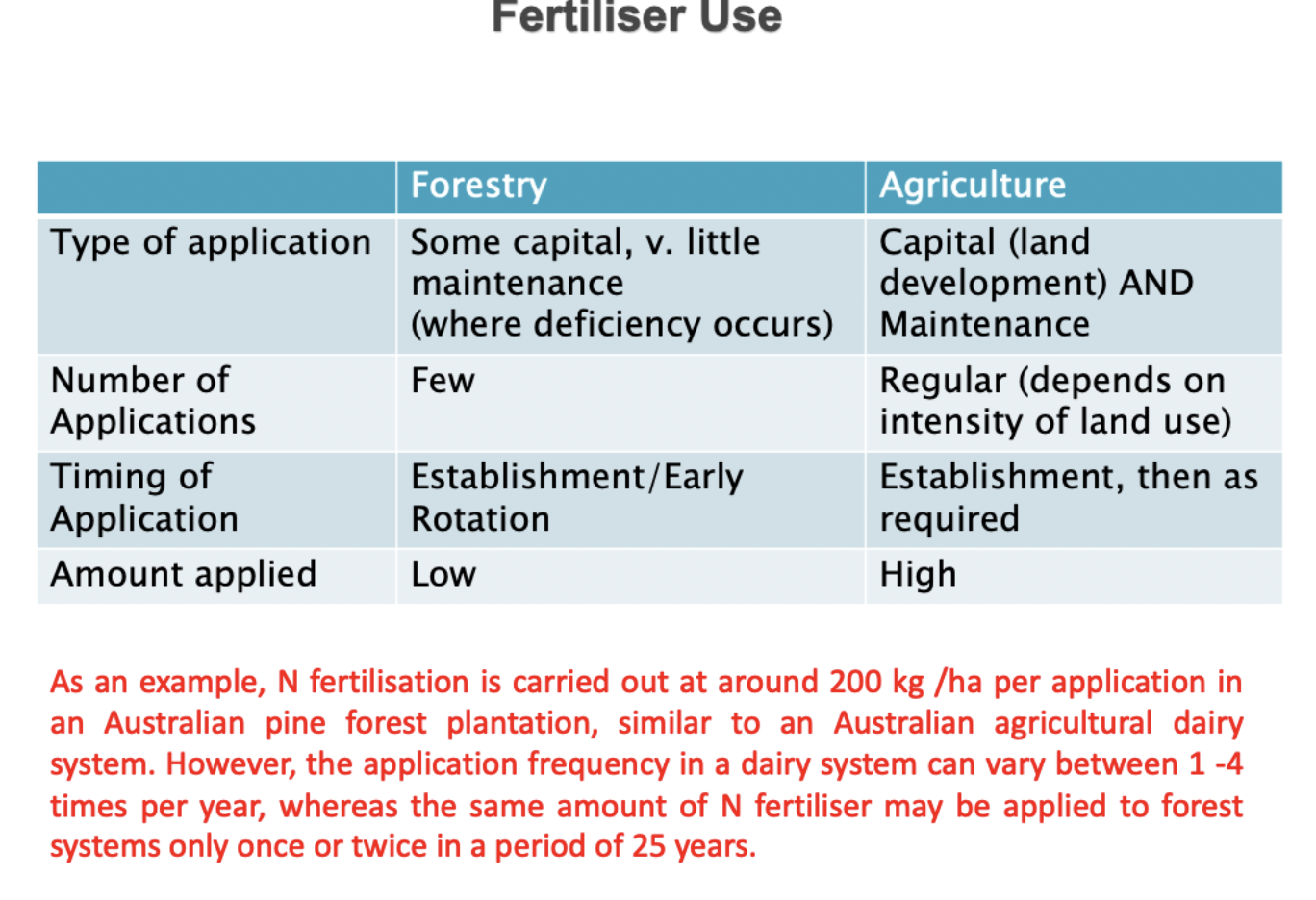
fertiliser use
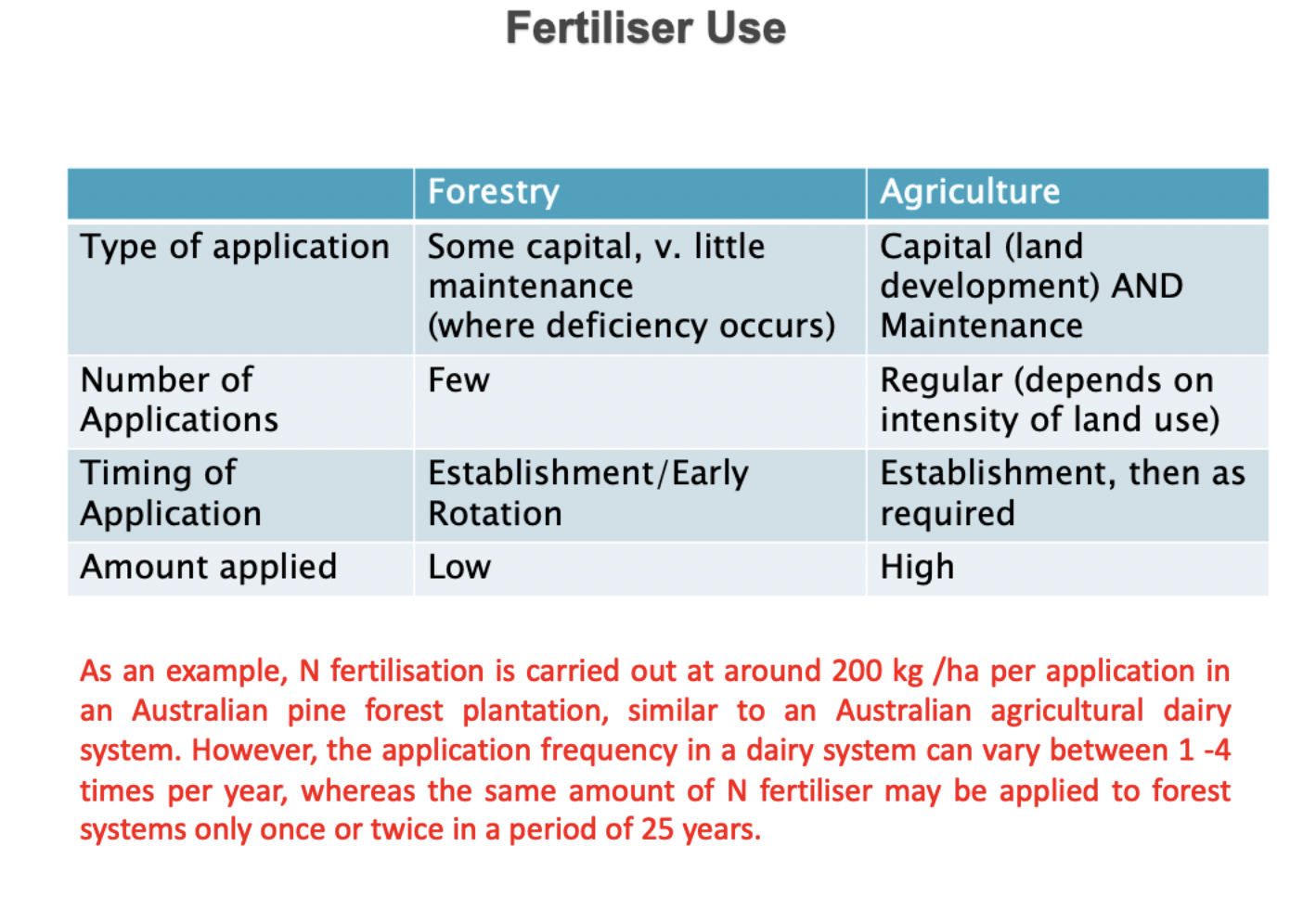
nutrient deficiencies
N= pale yellow-green leaves (chlorosis), stunted plant growth
P= purple leaves, no plant growth, little to no fruit/flowers
K= yellowing of the leaves outer edges, small pale fruit of poor quality
plant may be deficient in more than one, but they just show the most dominant effect.
Mobile nutrients
N, P, K, Mg
Can move out of older leaves to younger plant parts when supplies are inadequate